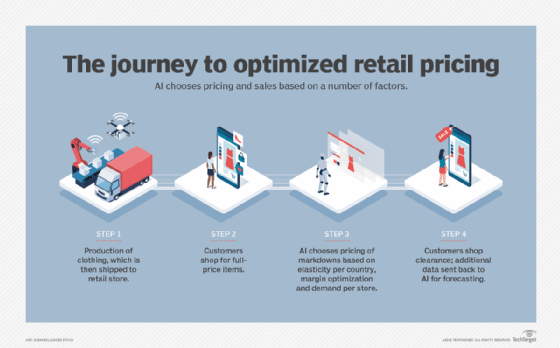
Getty Images/iStockphoto
4 ways businesses can use technology to fight inflation
As inflation rises, businesses have found ways to use tech -- including automation, IoT and digital deflation -- to fight higher prices and labor shortages.
As inflation throughout the world continues to rise, some businesses have figured out how to use technology to fight inflation.
While CFOs look for ways to scale back and reduce spending, experts agree that businesses should instead take advantage of technology to reduce costs and get a leg up on the competition.
Sixty percent of organizations were facing significant wage inflation as of July 2021, according to Gartner. The Consumer Price Index (CPI), which indicates the monthly change in prices paid by U.S. consumers, is often referenced as a meter for inflation. As of May 2022, the CPI rose 8.5% over the previous 12 months -- the highest rate in more than 40 years.
While each company faces different challenges with inflation, technology has helped industries adapt and improve despite tighter budgets.
Tech helps retailers get ahead
In retail, businesses use technology to reach consumers in several ways. While retailers have used cutting-edge technology for a while -- think virtual fitting rooms or in-store augmented reality experiences -- not many have used tech in the pursuit of cutting costs to battle inflation.
Here are some examples of how retailers today are taking advantage of technology to keep existing customers and bring new ones in.
1. Smart shelves
Using AI and real-time data, stores can keep track of the inventory on their shelves at any given time using smart shelves. As a wireless inventory control system, smart shelves use weight sensors to indicate how much product is on store shelves. The sensors then relay this information to the retailer's customer experience (CX) platform. This data can be used to keep a balanced inventory and track shopping trends across multiple stores. Retailers can then adjust their inventory to better meet demand, avoid overordering and keep items they know are profitable in stock. This can cut costs and streamline inventory management. On the customer experience side, shoppers can visit store websites to see if an item is in stock and then order it for delivery or pick up. If an item is out of stock, the company's website lists other stores where the item is available. This real-time information can improve the customer experience and enhance customer loyalty. Maintaining and growing a customer base during times of inflation can be invaluable to businesses.
2. Frictionless checkout
With frictionless checkout, consumers can use technology such as tap-to-pay, digital wallets and in-app payments to make their checkout experience faster and easier. Frictionless checkout can help retailers cut costs on labor and improve the customer experience by avoiding lengthy lines, especially for customers only purchasing a few products. A common concern of removing a human employee from the checkout process is fraud and theft. However, computer vision-based sensors can identify individual products and tally the price for a customer. They can also detect concealment or label switching.
3. AI and IoT
Many retailers have embraced the use AI and IoT as they look for new ways to attract customers. Both technologies are used to increase personalization of smartphone apps and marketing campaigns, as well as to create better online shopping experiences. AI also provides retailers with the ability to use predictive analytics to help forecast customer purchasing habits, while showing users personalized products and services.
A retailer can choose to increase or decrease prices based on patterns of customer demand in different products, categories or locations. This helps businesses adapt to changing consumer spending habits faster and reduce costs when and where necessary.

4. Digital twins
A digital twin is a virtual representation designed to reflect a physical object or process. Retailers use digital twins with AI and machine learning (ML) to create sophisticated, virtual simulations of supply chains. Businesses can update models with real-time and real-world data, which helps analyze supply chain systems and identify possible problems before they become reality.
As the AI and ML systems learn, better simulations help predict consumer behavior, analyze inventory and shipping data, and perform supplier stress tests. This helps retailers save money by discovering and addressing potential issues before they happen, while adjusting quickly to market changes.
Robots and automation continue to cut costs
Robotics and automation can help reduce certain business costs. With self-service checkout lanes at the grocery store or robots sorting through inventory at a warehouse, these technologies continue to be go-to investments to help some businesses reduce costs. But with rising labor costs, there's an opportunity to increase automation and robotics adoption to offset this trend.
More than ever before, the number of possible automated tasks continues to rise. Several industries are increasing their automation adoption, including food processing, general manufacturing and electronics manufacturing.
An example of an increase in automation adoption to help reduce costs is in the hotel industry. With a labor shortage, rising rates and the shifts in travel habits due to COVID-19, hotels are enticing guests with automated self-service options. Guests can manage their stays from their mobile devices with automated systems, such as cashless tipping for housekeeping and contactless self-service check-in.
Another example is in factories and warehouses, where robotics helps with logistics and complex processes. By using robots to perform mundane, repetitive tasks, businesses can allocate their employees' time and effort to more critical and delicate tasks.
Robots have also helped businesses combat labor shortages during and after the pandemic. New robots are designed to augment operations and work in partnership with humans. Robots use AI to navigate facilities and perform tasks, such as sweeping floors, detecting spills, and sorting and delivering mail. Robots can also collaborate with employees and improve fulfillment processes.
Digital deflation helps mitigate inflation
While inflation threatens the profitability of businesses, it can also be a catalyst for businesses to analyze their spending and push forward with key cost-reduction strategies. This can include investing in technology to reduce long-term costs.
Digital deflation focuses on investing in technology with the goal of reducing business costs in the long term, according to Gartner. While spending can seem counterintuitive during inflationary times, implementing digital initiatives can lead to the deflation of business costs. Consequently, businesses can maintain profitability in the long term and pass along these savings by reducing the prices of goods and services -- essentially deflating an inflated cost bubble.
While most industries are feeling the inflation crunch, it's important to think innovatively and long term. Businesses should look for creative ways to use technology to their advantage, whether that involves keeping a loyal customer base or improving upon outdated systems.







